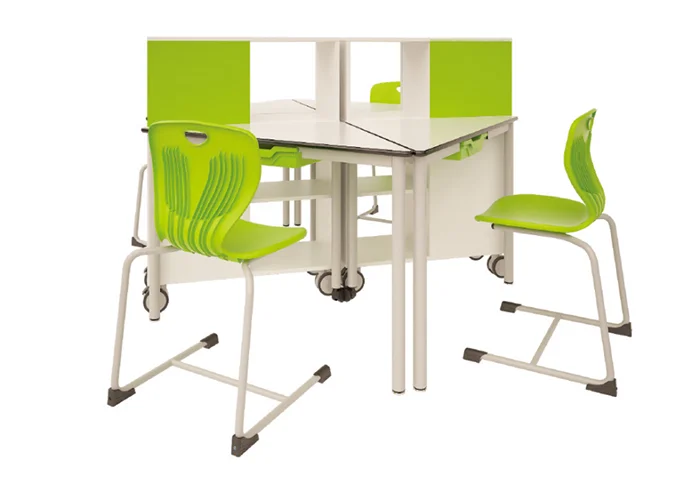Transform Your Classroom with Innovative Modular Desks for Schools
多行文本内容元素
富文本内容绑定数据后可解析HTML语言内容
Release time:
Jul 14,2025
Summary:Transform Your Classroom with Innovative Modular Desks for Schools
The Evolution of Classroom Furniture: A Shift Towards Flexibility
In today's educational landscape, traditional classroom setups are becoming obsolete. The need for **flexible learning environments** has never been more critical. Gone are the days when rows of fixed desks dictated the flow of classroom interactions.
Innovative mod
Transform Your Classroom with Innovative Modular Desks for Schools
The Evolution of Classroom Furniture: A Shift Towards Flexibility
In today's educational landscape, traditional classroom setups are becoming obsolete. The need for **flexible learning environments** has never been more critical. Gone are the days when rows of fixed desks dictated the flow of classroom interactions.
Innovative modular desks are redefining how we perceive classroom furniture, allowing educators to create dynamic learning spaces that adapt to various teaching methodologies. This shift not only caters to the diverse learning styles of students but also fosters collaboration and engagement.
Understanding Modular Desks: What Makes Them Unique?
Modular desks are designed with versatility in mind. These desks can be easily rearranged, reconfigured, or even expanded, depending on the classroom's needs. Key features include:
1. Flexibility in Design
The hallmark of modular desks is their **flexibility**. Educators can quickly modify the layout to facilitate group projects, individual work, or discussions, depending on the lesson plan. This adaptability encourages a more interactive learning environment.
2. Efficient Use of Space
In schools where space can be limited, modular desks maximize the available area. They can often serve multiple purposes—functioning as a traditional desk one day and transforming into collaborative workspaces the next. This feature is especially beneficial in classrooms with shifting student populations or varying class sizes.
3. Enhanced Comfort and Ergonomics
Modern modular desks prioritize student comfort. Many designs include features like adjustable heights and ergonomic shapes that cater to a wide range of body types. Comfortable students are more likely to engage with the material, resulting in improved learning outcomes.
Why Choose Modular Desks for Your Classroom?
Investing in modular desks offers numerous advantages that extend beyond aesthetics. Here are several compelling reasons why schools should consider making the switch:
1. Promotes Collaborative Learning
Collaborative learning is a pedagogical approach that encourages students to work together to solve problems. Modular desks facilitate this by allowing easy reconfiguration for group work, fostering teamwork and communication skills among students.
2. Adapts to Different Teaching Styles
Every educator has a unique teaching style, and modular desks can accommodate this diversity. Whether instruction is led through traditional lectures, group discussions, or hands-on activities, these desks can be arranged to support various methods effectively.
3. Supports Differentiated Learning
Not all students learn in the same way. Some may thrive in a quiet, individual setting, while others may excel in collaborative environments. Modular desks provide the flexibility to tailor the learning space to meet the specific needs of each student.
4. Encourages Active Learning
Active learning strategies—such as discussions, problem-solving, and case studies—are essential for student engagement. Modular desks can be used to create an environment conducive to active learning by easily forming discussion circles or small group clusters.
5. Streamlines Classroom Management
With modular desks, teachers can quickly pivot between different activities throughout the lesson. This adaptability keeps students engaged and minimizes downtime, allowing for a more streamlined classroom management experience.
Exploring Different Types of Modular Desks
As schools consider transitioning to modular desks, it's essential to understand the various types available. This knowledge helps make informed decisions based on the specific needs of the classroom.
1. Collaborative Desks
These desks are specially designed to facilitate group work. Often featuring rounded edges and connected surfaces, collaborative desks encourage teamwork and interaction among students.
2. Stand-Up Desks
Stand-up desks offer a unique solution for active learners who may struggle with traditional seating arrangements. They promote better posture and can help enhance focus, making them a valuable addition to any classroom.
3. Adjustable Desks
Height-adjustable desks allow students to find their optimal working position, accommodating both sitting and standing preferences. This adjustability is crucial for promoting comfort and reducing fatigue during long hours of study.
4. Mobile Desks
Equipped with wheels, mobile desks can be easily moved and rearranged in the classroom. This feature is particularly helpful for teachers who frequently shift between teaching styles or need to quickly adapt the space for different activities.
5. Integrated Technology Desks
Incorporating technology into the classroom is essential for modern education. Integrated technology desks come with built-in charging ports and connectivity options, allowing students to seamlessly use laptops, tablets, and other devices.
Factors to Consider When Choosing Modular Desks
Selecting the right modular desks for your classroom requires careful consideration of several factors. Here are some critical aspects to keep in mind:
1. Durability and Materials
Choose desks made from high-quality, durable materials that can withstand daily wear and tear. Look for options that are easy to clean and maintain, as school environments can be demanding.
2. Size and Configuration Options
Evaluate the available space and ensure that the desks fit comfortably within the classroom. Consider how the desks can be configured to maximize learning opportunities.
3. Budget Constraints
Budget is a significant factor in any school furniture purchase. It's crucial to balance cost with quality. Prioritize investments that offer long-term value and adaptability while remaining within budgetary limits.
4. Aesthetic Appeal
The visual environment of a classroom can impact student attitudes and engagement levels. Choose modular desks that complement the overall classroom design and create an inviting learning atmosphere.
5. Feedback from Educators and Students
Involve teachers and students in the selection process. Gathering feedback on their preferences can lead to better choices that meet the needs of all classroom participants.
Implementing Modular Desks in Your School: A Step-by-Step Guide
Transitioning to modular desks involves more than just purchasing new furniture. Here's a structured approach to ensure a successful implementation:
1. Assess Current Needs
Start by evaluating the current classroom setup and identifying areas for improvement. Gather input from educators, students, and administrators to understand the specific needs of your school.
2. Research Desk Options
Take the time to research various modular desk options. Compare features, prices, and reviews to find the best fit for your classrooms.
3. Create a Budget
Establish a budget that includes not only the cost of the desks but also any additional expenses, such as shipping, assembly, or installation. It's essential to account for these factors to avoid unexpected costs.
4. Pilot the New Desks
Before a full rollout, consider piloting the new modular desks in a few classrooms. This trial period allows you to gather feedback and make any necessary adjustments.
5. Provide Training for Educators
Once the desks are in place, offer training sessions for teachers on how to maximize their use. This training can include strategies for effective classroom management and lesson planning using the new furniture.
FAQs About Modular Desks for Schools
1. What are the benefits of modular desks in classrooms?
Modular desks enhance flexibility, promote collaboration, support different teaching styles, and encourage active learning, making them ideal for modern educational environments.
2. How do modular desks improve student engagement?
By allowing for various configurations and seating arrangements, modular desks create an interactive learning atmosphere that keeps students engaged and focused on the material.
3. Are modular desks suitable for all types of classrooms?
Yes, modular desks can be adapted for various classroom settings, including traditional lecture formats, collaborative group work, and individual study areas.
4. How do I maintain and clean modular desks?
Choose modular desks made from durable, easy-to-clean materials. Regularly wipe down surfaces with appropriate cleaning solutions to maintain their appearance and longevity.
5. Can modular desks accommodate technology?
Many modern modular desks come with integrated technology features, such as charging ports and connectivity options, making them suitable for a tech-enhanced learning environment.
Conclusion: Embrace the Future of Classroom Design with Modular Desks
Incorporating innovative modular desks into educational settings is not just a trend; it is a necessary evolution in classroom design. These versatile and adaptable pieces of furniture foster collaboration, enhance learning experiences, and create environments that cater to the diverse needs of students.
As we look towards the future, it is essential for schools to prioritize flexible furniture solutions that support active learning and inclusivity. By investing in modular desks, educational institutions can significantly transform the learning experience, preparing students for the collaborative and interconnected world ahead.


